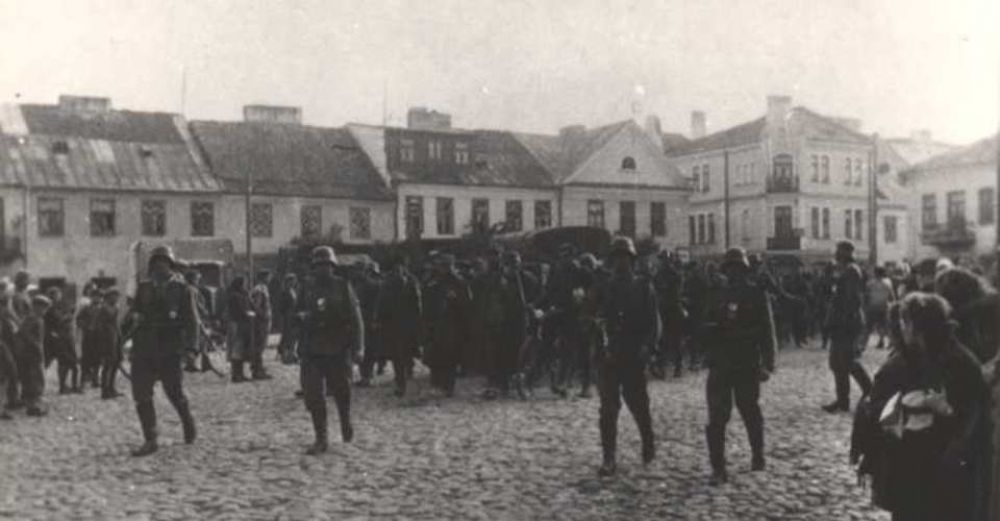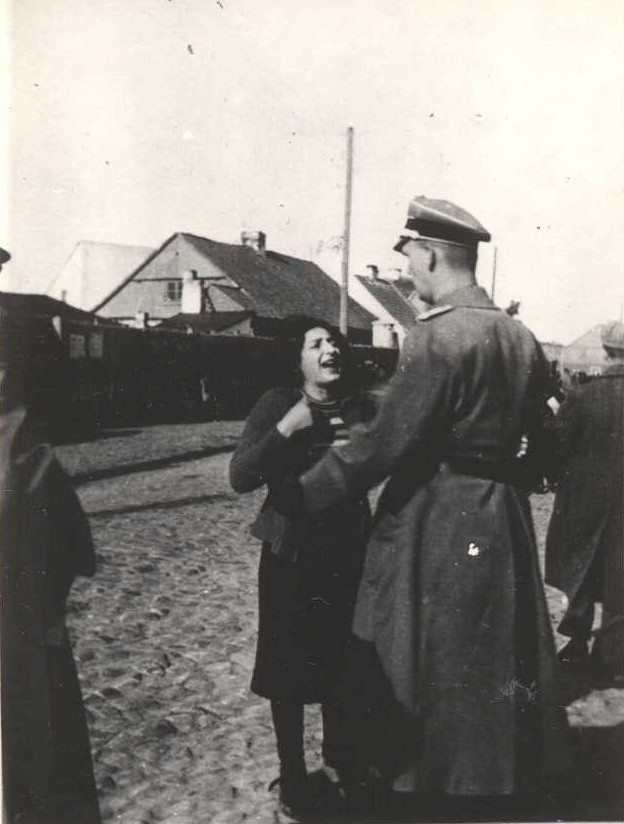- News
- Events
- Oneg Shabbat
- Collections
- Research
- Exhibitions
- Education
- Publishing Department
- Genealogy
- About the Institute
- Bookstore


Dating back to 1155, the pay privilege given by Duke Bolesław IV the Curly is the first historical mention confirming the existence of Płońsk. Around the castle formed a cluster of people, most of whom initially worked in the fields. In 1400 Duke of Masovia Ziemowit IV gave Płońsk city rights under the Chełmno Law, and merchants and craftsmen began coming to the town.
The earliest information on the Jewish settlement in Płońsk is from 1446. It includes information on the number of Jews paying taxes and the amount of these fees. In 1507 the Jews of Płońsk paid 5zl of coronation tax and in 1578 in the Jewish community of Płońsk lived 24 Jews paying taxes per head. Jewish merchants from Płońsk traded in leather products, potash and tar. The inventory of the royal estates from 1616 gives us a rich description of the property of the city, in which there are four Jewish houses, whose owners are obliged to give one and a half litre of saffron to the starosta.
For the first time, a shadow was cast on the Polish-Jewish relations during the Swedish Deluge, when Polish Jews were accused of helping the Swedes and therefore of treason. As a result, in the whole Polish-Lithenian Commonwealth robberies and carnage began. In April 1656, Stefan Czarniecki got to the area of Ciechanów and Płońsk. The majority of Jews of Płońsk, including Rabbi Zevi, had been murdered and their houses and belongings were destroyed.
In 1667, King John II Casimir granted Jews a privilege allowing them to rebuild their houses and reopening their shops and workshops. In 1670, his successor, Michał Korybut Wiśniowiecki, renewed the privilege and allowed Jews to settle in Płońsk, possess houses, work in trade. The Jews could drink vodka, slaughter livestock and possess slaughterhouses, and also build a synagogue and a separate cemetery.
In 1790 in Płońsk lived 496 Jews, in 1808 already 2801. Since 1808 Płońsk had been one of four leading cities with the biggest percentage of Jewish population. In 1808 Jews constituted 73.6% of the town’s population.
The richest collection of memoirs of Jews of Płońsk who survived the Holocaust are short stories and accounts included in „Księga Płońskich Żydów” [The Book of Jews of Płońsk] published in Hebrew in Tel Aviv in 1963. We can find there a story by the most famous Jew of Płońsk, Dawid Ben Gurion (born 16.10.1886) entitled „My youth in Płońsk”. The first prime minister of Israel remembers Płońsk as a city of the Maskalim and Zionists, where most of the Jews could speak Hebrew. The Jews of Płońsk were one of the first group to settle in Palestine — they emigrated during the Second Aliyah (1904–1913), which was caused by a wave of pogroms in Europe. In the late 19th century, the Jews of Płońsk lived in the buildings by the square and on the streets connecting the city centre with the marketplace.
Years later, in a diary published in 1970, Dawid Ben Gurion wrote: For many of us, the anti-Semitic feelings had little to do with our devotion to zionism. Personally, I have never suffered from anti-Semitic oppression. Płońsk was free of this. (...) The number of Jews and Poles in the city was more or less the same, being about 5000. However, the Jews formed a tight, centralised group taking up a small piece of land, whereas the Poles were scattered, living in remote environs and rural areas. As a consequence, when a gang of Jewish boys met a Polish gang, inevitably they came from the suburbs and as a result had smaller potential than the Jews, who, even though were smaller in numbers at the beginning, had the possibility to quickly call backup from the whole quarter.
In „Księga Żydów Płońska”, Dr Gelber writes that the 19th century was a special time when the culture of the Jewish community of the town was especially flourishing. Jewish students, including young residents of Płońsk, in a special way, were the eulogists of the Polish-Jewish brotherhood. They participated in the activities of the national liberation movements and demonstrations. They went to the countryside to amalgamate peasants and farm workers; they raised money for organizations.
Attention should be paid to Witman from Płońsk, a 26-year-old student of year four at the Rabbinical School of Warsaw, who was arrested for participation in a conspiracy and demonstration in 1861 and for distribution of illegal books and fliers. Gelber also writes about the time when intellectual culture was flourishing and new political currents and religious thoughts were emerging among the Jews of Płońsk. In 1865, in Płońsk, a group of Maskalim founded Hewrat Dorszej ha-Tora we ha-Hochma (Hebrew for „The Association of Seekers of the Torah and Wisdom”), which was supposed to interest others in the Hebrew language and literature.
On the initiative of the enlightened Jews, with Jehoshua Grunbaum being the leader, a Jewish public school was founded. The circle of Jewish intelligentsia, whose first language was Polish were interested in Polish culture and literature; they organized meetings during which Polish books were often read.
The outbreak of the World War II
Rivka Szachar in the memoir entitled „Visiting the family home” writes that at the beginning of the 20th century, Płońsk was a typical, provincial town, which only in 1937 was struck by a wave of anti-Semitism. From a story by Jakub Neta entitled „The last years before the Holocaust”, we learn that in Płońsk, they did not see the storm coming and the public mood did not indicate that the worst was before them. People did not want to accept the fact that the war was approaching them. In 1931, in Płońsk lived 4 913 Jews who constituted 43% of the population. At the very beginning of the war, there were 6 to 8 thousand Jews living in Płońsk.
Northern Masovia was incorporated into the Third Reich and a German administrative unit Regierungsbezirk Zichenau (Ciechanów), belonging to East Prussia region, was formed. Before the outbreak of the Second World War, the part of the Warsaw voivodeship from which the Regierungsbezirk Zichenau was formed, had been inhabited by about one million people, including about eighty thousand Jews. The cities of northern Masovia were occupied by the troops of the Wehrmacht already at the beginning of September, which caused a massive migration of the Jewish population, whose main destination was Warsaw.
About the first days of the war in Płońsk we learn in details from the memoir „And so it began” by Chaia and Zelig Krojnów. The Germans entered Płońsk on Monday 4th September, and the harbinger of repression against the Jews of Płońsk was the confiscation of their property, closing their shops and robbery of goods. On 18th September an announcement was hung in the town, ordering the male Jews over 17 to gather on 19th September at 9 am in the courtyard of the prison of Płońsk in Warszawska Street. The other male Jews were to turn up every morning in school for „a workout”.
Registration took place in the courtyard of the prison, but with tortures and harassment. The Jews were ordered to go into trenches. The Germans poured water on them and cut their beards. When the Jews had filled in the forms, they had to stand in line again and the Germans chose a few who were hit and arrested. They were informed that if the Jews from the city did not turn up for work or they did not come to the aforementioned workout, the hostages would be shot dead. In November 1939, for the first time, the Germans requested 100000 zl ransom. When the money collected by the Jewish community had been paid, the hostages were released.
Olga Branicz, writing about the first weeks of the war in Płońsk, remembers huge waves of migration of the Jewish society from various cities. To Płońsk came Jews from Rypin, Sochocin, Raciąż. Płońsk residents, regardless of their religion, had to give to the Germans a few most beautiful flats in the main streets of the town and furniture.
Since the winter of 1939, the Jews had to wear on their backs and chests a yellow patch, on which inscription Jude was added later. They could not walk on the pavements; the Germans forced the Jews to do unfree labour, food coupons were implemented. The distribution of work took place in the office of Abraham Lewi who, thanks to the fact that he knew German, became the first unofficial representative of the Jews to the German authorities.

In the summer of 1940, as ordered by the German authorities, the Jewish Council was formed. At the Judenrat in Płońsk operated an employment office (Arbeitsamt), the Committee to Aid and the Jewish Police. At the beginning The Judenrat consisted of 6 people (Szlomo Bogata, Szlomo Fuks, Jankiel Gryc, Ruben Grodowicz, Jakub Ramek – the chairperson, Fromm Leon – secretary), and after the ghetto had been closed, the Jewish Council had 40 members. The smooth functioning and effective actions of The Judenrat in Płońsk meant that many Jewish refugees sought shelter in Płońsk.
All manifestations of public life were stifled by the Germans. It was not allowed to meet on the streets, because it raised suspicion of subversion. The Jews could not do cultural activities, religious life was paralysed by the restrictions of the occupier. They had destroyed the synagogue, including the Torah scrolls and works of art of the highest class, and it served as a storage.
Getto in Płońsk

In September 1940, the boundaries of the Jewish quarter in Płońsk were marked out and the Jews were separated from the Polish. At first, the ghetto was open. However, in May 1941 it was fenced with a barbed wire. It was located within the following streets: Warszawska, Kozia, Krzywa, Płocka — to the church, and part of Wyszogrodzka street. The area of the ghetto took up about 1km² and just before its liquidation up to twelve thousand Jews lived there.
The area was guarded by the Jewish police consisting of about 40 police officers, who were maintaining order armed with leather whips. Every visit of a German to the ghetto resulted in maltreatment of the Jewish population, including setting their beards on fire and shooting people without a reason. After the ghetto had been closed, the situation was getting worse and worse every day, the refugees from other cities were left without a roof over their heads.
During the epidemic of typhus (autumn-winter 1941), which was causes by poor sanitary conditions in the ghetto, Dr. Fenigstajn died. Thanks to Jakub Ramek, Dr. Artur Bera was fetched from Warsaw. In the Płońsk Ghetto, he organized a hospital and pharmacy, serving also the residents of other ghettos in the area. Dr. Bera ordered the creation of a bath for the sick in the old Beit Midrash, and The Judenrat imposed taxes on the residents. The amount ranged from 0.6 to 2.75 Reichsmarks. At first, showers with cold water were installed, and later with hot water.
In the ghetto there was a public kosher canteen serving food without meat dishes. It was created thanks to the voluntary work of a few Jews — Chaim Moszkowicz installed the oven. However, due to financial difficulties, the Judenrat stopped supporting the canteen. The orphanage in the Płońsk Ghetto was led by a teacher, Ms Grynberg. About 40 children at the age of 4 to 10 were under her supervision.
Olga Branicz remembers how terribly Fiszel Grossman was lynched for smuggling food. Another tragic event was shooting Epsztajn dead after being caught on the road to Warsaw. The Germans forced the residents of the ghetto to watch both of the executions.
On Sunday, 22nd June, 1941, on the day when the Third Reich attacked the Soviet Union, the Germans took the refugees to the camp in Pomiechówek. Already since May 1941 about 3 thousand Jews from the area of Płońsk who did not have papers entitling them to be in the ghettos (so called „the illegals”) had been gathered there.
On 13th July 1942 a control of the Jews gathered on the square in Płońsk was conducted. The Germans chose 1200 of them who were staying in the town illegally and took them to the camp in Pomiechówek. Not more than 200 people, who were scattered around other ghettos, managed to survive the six-week hunger. More than 2 thousand Jews, including women and children, lost their lives in the dungeons of the prison in Pomiechówek.
The liquidation of the Płońsk Ghetto began in the fall of 1942. The first transport left on 28th October, the second during the night of 15th December, 1942. At the Auschwitz-Birkenau camp, 12 thousand Jews from the Płońsk Ghetto were murdered.
Letters from Płońsk
The Ringelblum Archive (The Underground Archive of the Warsaw Ghetto) includes postcards and sheets of paper thrown away from the trains going from Płońsk to Auschwitz. They are the last documents allowing us to finish the story of the Jews from Płońsk. The letters were written on scraps of paper and postcards. The information left on the stations got to Warsaw thanks to the rail industry workers, who cooperated with Oyneg Shabbos. The first sheet was found still at the railway station in Płońsk. Unidentified sender writes to their family in the Warsaw Ghetto, 16th December, 1942:
Please, put into the nearest postbox
It is early morning. We are in a wagon with the whole family. We are the last group to leave. Płońsk is cleared out. Please go to the Bams, 6 Niska Street and give our best regards to them.
Another letter found at the railway station in Legionowo, from 16th December, 1942, written by Dawid from Płońsk to his relatives in the Warsaw Ghetto:
Please, put into the postbox as a courtesy
Warsaw, Nalewki 47/19
Today we set off from Płońsk. Our whole family and all Jews left. Be clear-headed because we are going to the wedding. Goodbye, Dawid
Letters from 16th and 17th December, found at the stations Warszawa-Praga and Częstochowa. Laja from Płońsk writes:
At the station Praga, i am writing a few words to you. We are going God knows where.
Gilta from Płońsk to her family in Muranowska Street in Warsaw:
Dear ones! We are now passing through Czestochowa, so I am writing a few words to you. We have also passed Warsaw. We are going to work. Hope for the best. I am not giving you the new address, because I do not have it yet. Goodbye.
Guta Fuks:
With the whole family, we are passing through Częstochowa. Where we are going, I don’ t know. Goodbye and best wishes.
Marek provides more detailed information about what is going on during the transport:
Since yesterday morning, we have been on the road. Yesterday, for a few hours we were in Praga on the train. I am, we are, in Częstochowa at the station. Apparently, we are going to a labour camp to Tarnowskie Mountains or to Oświęcim. I am with great pain in my heart because of my unhappiness with Lonia and Henio. Whether I will see them again. I feel very lonely.